Blog
Rare Begonia Rex Varieties: Discover Why They’re Worth the Effort
Have you ever caught yourself staring at a plant so stunning that it barely seemed real? That’s the exact feeling rare Begonia Rex varieties evoke when you first encounter them. These living masterpieces with their swirling patterns, metallic sheens, and rich colors aren’t just plants – they’re conversation pieces that can transform any indoor space into a personal art gallery.
As a longtime plant collector and gardening enthusiast, I can tell you that once you venture into the world of rare Rex Begonias, ordinary houseplants may never quite satisfy you again. But are these exotic beauties worth the extra effort and investment? Let’s explore why plant collectors worldwide are falling under the spell of these painted-leaf treasures.
Introduction to the World of Rare Begonia Rex Varieties
The Allure of the Rex Begonia: Why Collectors Seek Them
Rex Begonias stands apart from other tropical houseplants with its spectacular foliage that resembles abstract paintings. Their appeal lies not in flowers (which are typically small and unremarkable) but in their extraordinary leaves – spiraling, rippling, and displaying colors that seem impossible. This unique decorative foliage makes them prized among plant collectors who appreciate ornamental foliage plants.
These rhizomatous begonias capture attention with dramatic contrasts – silver against black, crimson against emerald, and spiraling patterns that draw the eye inward. Each variety offers something unique, making the hunt for rare specimens particularly exciting.
A Brief History
The story of Begonia Rex begins in the misty forests of Assam, India, where the original species was discovered in 1858. Since then, breeders and enthusiasts within the American Begonia Society and beyond have created hundreds of hybrids forming the begonia rex-cultorum group – each with distinctive patterns and colors.
What started as botanical curiosities quickly became Victorian status symbols, and today, rare Rex varieties represent the pinnacle of indoor plant collecting. Their journey from jungle floors to our living rooms spans over 150 years of careful cultivation and selective breeding.
Understanding What Makes a Begonia Rex “Rare”
What elevates a Rex Begonia from common to rare? Several factors:
-
Limited propagation success: Some varieties are notoriously difficult to propagate, keeping supplies naturally limited
-
Recency of development: Newer hybrids haven’t yet reached mass production
-
Striking or unusual characteristics: The more unique the pattern or coloration, the higher the demand
-
Stability: Varieties that hold their distinctive patterns without reverting
While common Rex Begonias might be found at garden centers for $10-15, rare varieties frequently command prices from $50 to well over $200 for particularly stunning specimens, reflecting their status among collectors.
Top 5 Most Coveted Rare Begonia Rex Varieties
Begonia ‘Escargot’: The Spiral Wonder
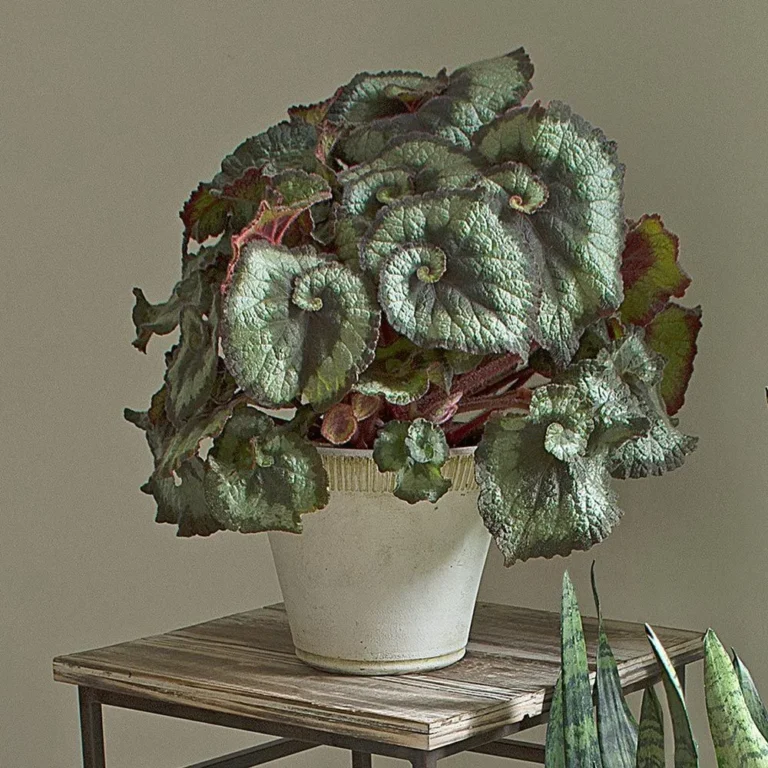
Begonia ‘Escargot’ earns its name from its remarkable spiral pattern that unfurls like the shell of its namesake snail. Each leaf creates a perfect pinwheel of silver and dark green, with the spiral becoming more pronounced as the leaf matures.
What makes Escargot special is the mathematical precision of its growth pattern – a natural example of the Fibonacci sequence that fascinates both plant enthusiasts and those appreciative of natural mathematics. This variety requires patience, as the spiral shows best on mature, well-developed leaves.
Begonia ‘Fireworks’: Explosive Patterns and Colors
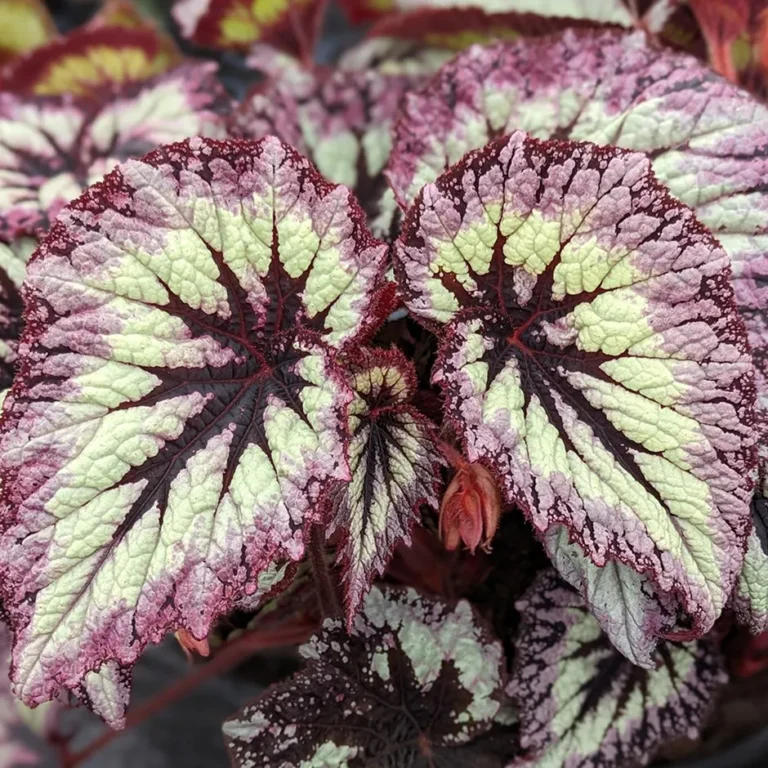
True to its name, Begonia ‘Fireworks’ looks like a frozen explosion of color on each leaf. Its deeply cut, star-shaped leaves feature a dark background with splashes of silver, pink, and red that radiate from the center like a starburst.
This variety commands attention in any collection, with each leaf slightly different in its pattern, making every plant unique. Its dramatic coloration and shape make it particularly popular with photographers and interior designers seeking statement plants.
Begonia ‘Black Velvet’: Dark and Mysterious Beauty
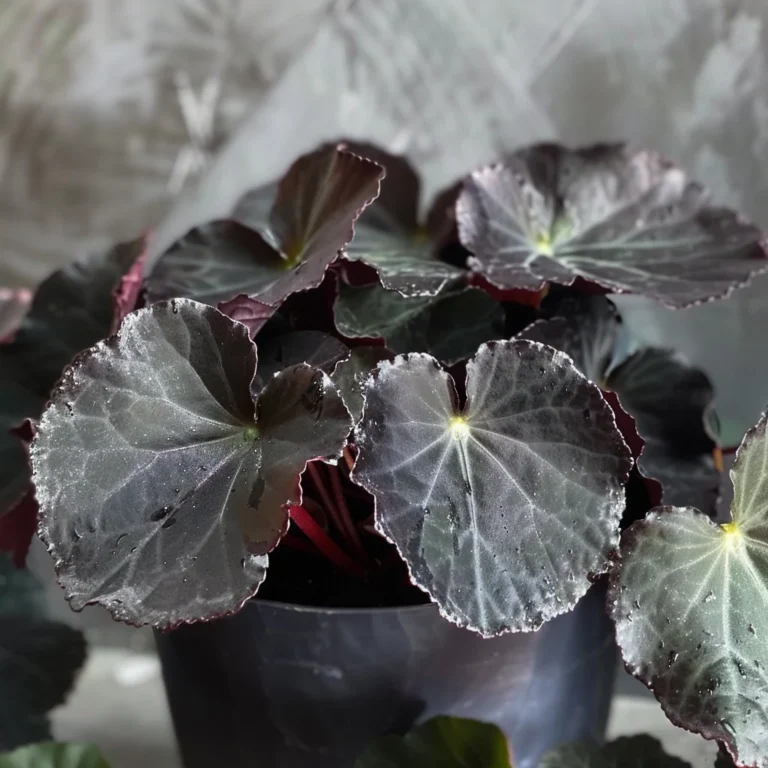
Among the most haunting of the Rex varieties, Begonia ‘Black Velvet’ features leaves so dark they appear nearly black, with subtle silver veining that catches the light like threads of moonlight. The texture lives up to its name, with a velvety surface that begs to be touched.
This variety requires particularly careful cultivation, as its dark leaves show water spots more prominently than lighter varieties. However, the dramatic effect of these nearly-black leaves against other plants makes it worth the effort for serious collectors.
Begonia ‘Silver Swirl’: Metallic Elegance in Leaf Form
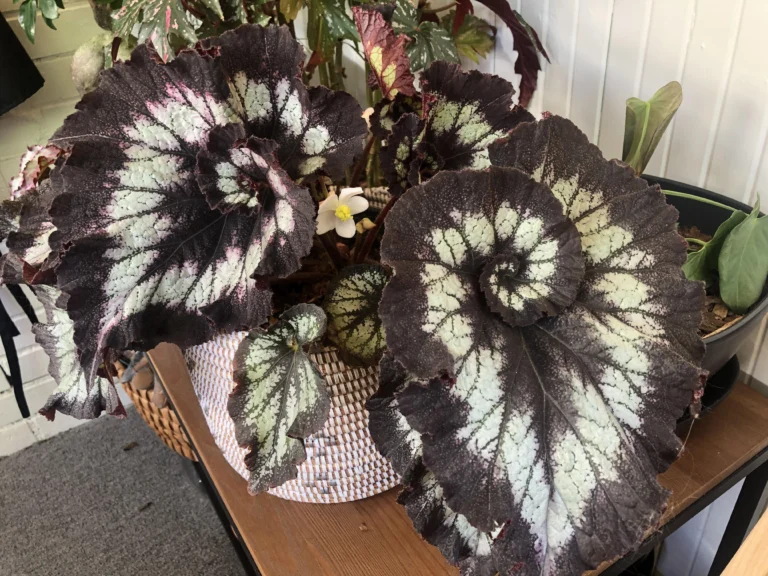
Begonia ‘Silver Swirl’ showcases why Rex Begonias are called “painted-leaf” plants. Its leaves display a metallic silver sheen that seems to glow from within, swirling over a background of deep green with burgundy edges. The effect changes depending on lighting, creating an ever-changing display.
This variety’s remarkable metallic finish occurs naturally – no artificial manipulation required. The iridescent quality results from specialized cell structures that reflect light in unique ways, creating a shimmering effect that photographers struggle to capture accurately.
Begonia ‘Red Tango’: Vibrant Dance of Colors
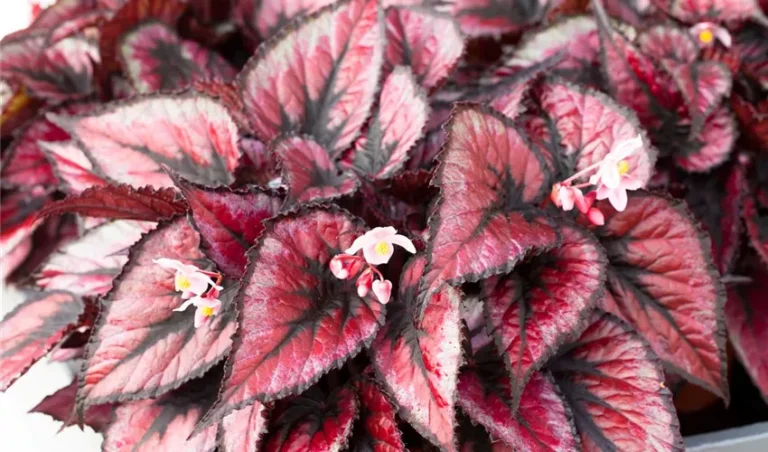
Begonia ‘Red Tango’ brings dramatic flair with its ruby-red to burgundy leaves, accented with silver patterns along the veins that create a striking contrast. The edges ripple and curl slightly, adding dimensional movement reminiscent of a dancer’s flowing costume.
This variety maintains its vibrant coloration even in lower light conditions, making it more versatile than some other red-leaved plants. Its rich colors provide depth in plant groupings and can be the perfect accent against silver or green varieties.
Read more: Top 5 Rare Begonias You Need to Know About
Why Rare Begonia Rex Varieties Are Worth the Investment
1. Unique Aesthetics: Nature’s Unparalleled Living Art
While many plants offer beauty, few provide the artistic impact of rare Rex Begonias. Their leaves resemble hand-painted canvases, with colors and patterns that artificial plants can’t replicate. Each plant develops uniquely, creating a one-of-a-kind living artwork that evolves through the seasons.
I’ve found that even non-plant people are drawn to these spectacular specimens, appreciating them as design elements rather than “just plants.” Their visual impact far exceeds their space requirements, making them perfect statement pieces for small homes.
2. Conversation Starters: Impressing Fellow Plant Enthusiasts
There’s a special joy in watching a fellow plant lover spot a rare Rex Begonia in your collection. These plants inspire connection, conversation, and community among enthusiasts, often leading to trading opportunities and new friendships built around shared appreciation.
In our increasingly digital world, physical collections of beautiful, difficult-to-obtain items provide tangible satisfaction that virtual possessions cannot. Rex Begonias represent botanical achievements and a connection to a global community of collectors.
3. Potential Value Increase: The Economics of Rare Plants
While most houseplants depreciate after purchase, rare varieties often follow a different trajectory. Limited-availability Rex Begonias frequently appreciate in value, particularly when you can propagate them successfully. A $50 investment can potentially become several plants worth $50-100 each within a year or two.
The indoor plant market has seen sustained growth in recent years, with rare varieties setting record prices at auctions and online marketplaces. Carefully chosen specimens represent not just aesthetic value but potential financial return for patient collectors.
4. Horticultural Challenge: The Satisfaction of Successful Cultivation
Growing common plants is enjoyable, but mastering the care of demanding varieties brings deeper satisfaction. Rex Begonias require attention to humidity requirements, careful watering, and protection from direct sunlight, making them challenging enough to feel rewarding when they thrive.
Successfully propagating your first rare begonia cutting provides a sense of accomplishment that basic houseplant care simply can’t match. These plants teach patience, observation, and adaptability – skills that benefit any gardener.
Essential Care Guide for Rare Begonia Rex Varieties
Climate and Environmental Requirements
The secret to Rex Begonia’s success lies in recreating their natural habitat. These plants evolved in the humid understory of tropical forests, which means:
-
Humidity: Maintain 50-60% humidity minimum (higher is better)
-
Temperature: Keep between 65-75°F (18-24°C), avoiding cold drafts
-
Light: Provide bright, indirect light – morning sun is fine, but avoid harsh afternoon rays
I’ve found that grouping begonias with other humidity-loving plants creates beneficial microclimates, or you can use humidifiers or pebble trays to increase moisture levels. Their preference for indirect light makes them ideal for east-facing windows or slightly back from south/west exposures.
Soil Composition
Rex Begonias require a specific soil environment to thrive. The ideal soil mix should be:
-
Well-draining yet moisture-retentive
-
Rich in organic matter
-
Slightly acidic (pH 5.5-6.5)
My recommended mix combines:
-
1 part high-quality potting soil
-
1 part peat moss or coco coir
-
1 part perlite or pumice
-
1/4 part orchid bark
This combination provides the aeration, drainage, and moisture balance that these plants require. The addition of orchid bark also creates beneficial air pockets while retaining humidity.
Watering Techniques
Watering represents the greatest challenge with rare Rex Begonias. Their rhizomatous roots are susceptible to rot, yet they need consistent moisture. The key rules:
-
Water when the top inch of soil feels dry
-
Always water the soil, never the leaves
-
Use room temperature or slightly warm water
-
Ensure pots have adequate drainage holes
I use the bottom-watering technique for my collection, placing pots in a shallow tray of water for 15-20 minutes, and then removing them once the soil surface feels moist. This prevents water from splashing on precious leaves and ensures even moisture distribution.
Fertilization
Proper fertilization helps maintain the vibrant colors and patterns that make these plants special:
-
Use a balanced, water-soluble fertilizer (10-10-10 or similar)
-
Dilute to half the recommended strength
-
Apply every 2-3 weeks during the growing season (spring through fall)
-
Reduce or eliminate fertilization during winter dormancy
Organic options like diluted fish emulsion or worm castings work well but may require more frequent application. Avoid high-nitrogen fertilizers that promote leaf growth at the expense of coloration and pattern development.
Pest Prevention and Treatment for Valuable Specimens
Protecting your investment from pests is crucial. Rex Begonias may encounter:
-
Mealybugs: White cottony insects that cluster in leaf axils
-
Spider mites: Tiny arachnids that cause stippling on leaves, particularly in dry conditions
-
Thrips: Slender insects that cause silvery scarring on leaf surfaces
I recommend regular inspection (weekly is ideal), maintaining proper humidity (which naturally deters spider mites), and prompt isolation of any affected plants. For valuable specimens, I prefer manual removal and horticultural oils over harsh chemicals that might damage delicate leaves.
Displaying and Showcasing Your Rare Begonia Collection
Creative Display Ideas that Highlight Leaf Patterns
The extraordinary beauty of Rex Begonias deserves a thoughtful presentation:
-
Use contrasting backgrounds to highlight leaf patterns – dark varieties pop against light walls
-
Elevate plants on stands or shelves to bring them to eye level
-
Consider directional lighting to enhance metallic finishes and create dramatic shadows
-
Group varieties with complementary colors (silver/red, black/green) for maximum impact
I’ve found that rotating plants regularly ensures even growth and allows you to appreciate different aspects of their patterns. Consider small spotlights to create gallery-like displays that highlight your most spectacular specimens.
Pairing with Other Plants
While Rex Begonias shines as a soloist, they also play well with others:
-
Ferns: Their delicate textures complement the bold patterns of begonias
-
Peperomias: Similar care requirements but different growth habits create interest
-
Calatheas: Another patterned-leaf plant that shares humidity preferences
-
Trailing plants: Adds vertical dimension to begonia displays
Avoid pairing with succulents or other plants requiring significantly different care, as maintaining multiple environments becomes challenging.
Starting Your Rare Begonia Rex Journey
Setting Realistic Expectations and Goals
Begin your collection with clear intentions:
-
Start with 1-2 moderately challenging varieties before pursuing the rarest specimens
-
Master basic care requirements before attempting difficult propagation
-
Set a budget that acknowledges both purchase prices and necessary care equipment
-
Define your focus (color groups, pattern types, or specific hybridizer’s work)
Remember that some trial and error is inevitable – even experienced growers occasionally lose plants to experimentation or environmental challenges.
Building Knowledge and Skills Progressively
Success with rare Rex Begonias comes through education and practice:
-
Study the specific needs of each variety in your collection
-
Keep detailed records of care routines and plant responses
-
Learn from failures by documenting what doesn’t work
-
Develop propagation skills with common varieties before risking rare specimens
I’ve found that creating a care journal with photographs helps track seasonal changes and identify optimal growing conditions for different varieties in your specific environment.
Connecting with the Begonia Enthusiast Community
No rare plant journey should be solitary:
-
Join the American Begonia Society or local chapters
-
Participate in online forums and social media groups focused on begonias
-
Attend workshops and lectures when available
-
Share your successes and challenges with fellow enthusiasts
The collective knowledge of the begonia community far exceeds what any individual can develop, and shared enthusiasm makes the inevitable challenges more manageable.
Frequently Asked Questions
Q: How much should I expect to spend on a rare Begonia Rex variety? A: Prices for rare Begonia Rex varieties can range from $30 for somewhat uncommon types to $200+ for extremely rare specimens. Factors affecting price include rarity, size, condition, and current market demand. The most valuable varieties are often those recently developed or especially difficult to propagate.
Q: Can I grow rare Begonia Rex varieties if I live in a dry climate? A: Yes, even in dry climates, you can successfully grow these humidity-loving plants by using humidifiers, humidity trays, terrariums, or grouping them with other plants to create a microclimate. Many collectors in arid regions grow their most humidity-demanding varieties in glass cabinets or dedicated plant rooms where conditions can be controlled more precisely.
Q: How often do rare Begonia Rex varieties produce new leaves? A: Under optimal conditions, healthy Begonia Rex plants can produce a new leaf every 3-4 weeks during the growing season (spring through fall), with slower growth during winter months. Growth rates vary by variety, with some of the most intricately patterned types growing more slowly than simpler varieties. Regular, appropriate fertilization helps maintain steady growth.
Q: What’s the biggest challenge in maintaining a collection of rare Begonia Rex varieties? A: The biggest challenge is maintaining consistent humidity and avoiding water on the leaves, which can cause spotting and fungal issues. Finding the perfect watering balance is crucial for long-term success. Many collectors struggle with maintaining adequate humidity without encouraging fungal issues, particularly in homes with central heating or air conditioning that reduces ambient moisture levels.

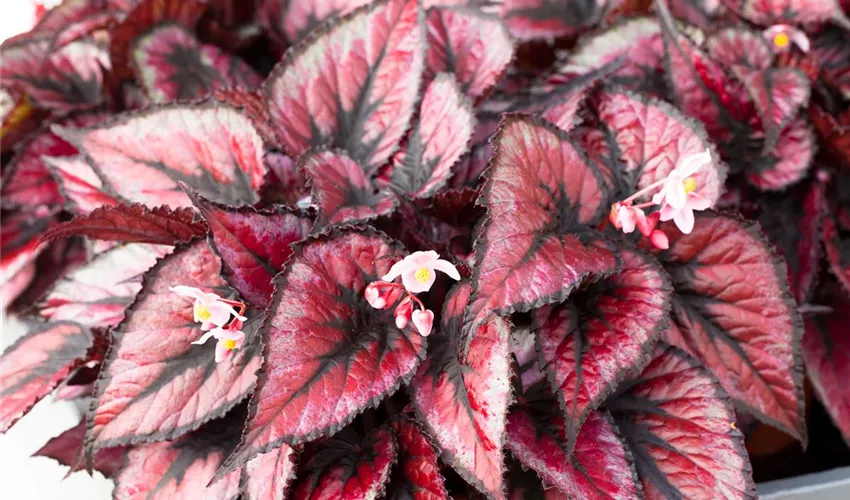
7 Vegetables to Plant in December for a Bountiful Winter Harvest
Winter gardening is a challenge many new gardeners shy away from. But if you’re among [...]
Dec
9 Common Christmas Cactus Problems and How to Fix Them
Have you ever walked past your Christmas cactus and wondered why it suddenly looks sad? [...]
Nov
Swedish Ivy Care: How to Grow a Healthy, Thriving Plant
Have you ever looked at your Swedish Ivy and wondered why the leaves are turning [...]
Nov
Avoid These 10 Garlic Planting Mistakes for Bigger, Healthier Bulbs
Growing garlic at home is one of the most satisfying things a gardener can do [...]
Nov
How to Prevent Christmas Cactus Bud Drop: Tips for a Healthy Bloom
Have you ever noticed your beautiful Christmas cactus (Schlumbergera) starting to lose its buds just [...]
Nov
Discover 7 Stunning Types of Night-Blooming Cereus
Have you ever waited for a flower that only opens at night and then disappears [...]
Nov